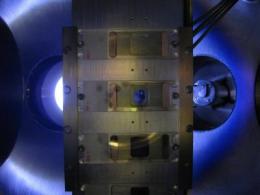From physorg, barium titanate (BaTiO3) nanoparticles in a polymer matrix could allow fabrication of improved capacitors able to store twice as much energy as existing devices. The improved capacitors could be used in consumer devices such as cellular telephones – and in defense applications requiring both high energy storage and rapid current discharge.
MIT researchers have found a way to measure the mass of single cells with high accuracy.

This illustration shows an artistic depiction of the concept that enables measuring the mass of a single bacterium and single nanoparticles in fluid with a very high resolution. A hollow resonator, represented by a hollow, fluid-filled guitar, vibrates while small particles, represented here by a bacterium, flow through it. As the particles flow through the resonator, they change the frequency (tone) of the vibration. Credit: Thomas Burg
So far, the researchers have weighed particles with a resolution down to slightly below a femtogram (10-15 grams), but Manalis believes that with refinements, the sensitivity could potentially be lowered by several orders of magnitude within a few years. “Every step along the way will open up new possibilities,” he said.
The researchers can also measure the mass density of particles or cells “by varying the density of the surrounding solution,” said Michel Godin, co-lead author and postdoctoral associate in biological engineering.
The research team is already looking into several applications for the new technique.
One area of great promise is creating a device that would mimic the cell-counting capabilities of flow cytometers, which are often used to monitor CD4 cell numbers in AIDS patients. By counting CD4 cells, a type of immune cell, doctors can tell how far a patient’s AIDS has progressed. However, flow cytometry devices, which work by bouncing light off a flowing stream of cells, are too large and expensive to be useful in developing countries where many AIDS patients live.

Brian Wang is a Futurist Thought Leader and a popular Science blogger with 1 million readers per month. His blog Nextbigfuture.com is ranked #1 Science News Blog. It covers many disruptive technology and trends including Space, Robotics, Artificial Intelligence, Medicine, Anti-aging Biotechnology, and Nanotechnology.
Known for identifying cutting edge technologies, he is currently a Co-Founder of a startup and fundraiser for high potential early-stage companies. He is the Head of Research for Allocations for deep technology investments and an Angel Investor at Space Angels.
A frequent speaker at corporations, he has been a TEDx speaker, a Singularity University speaker and guest at numerous interviews for radio and podcasts. He is open to public speaking and advising engagements.

